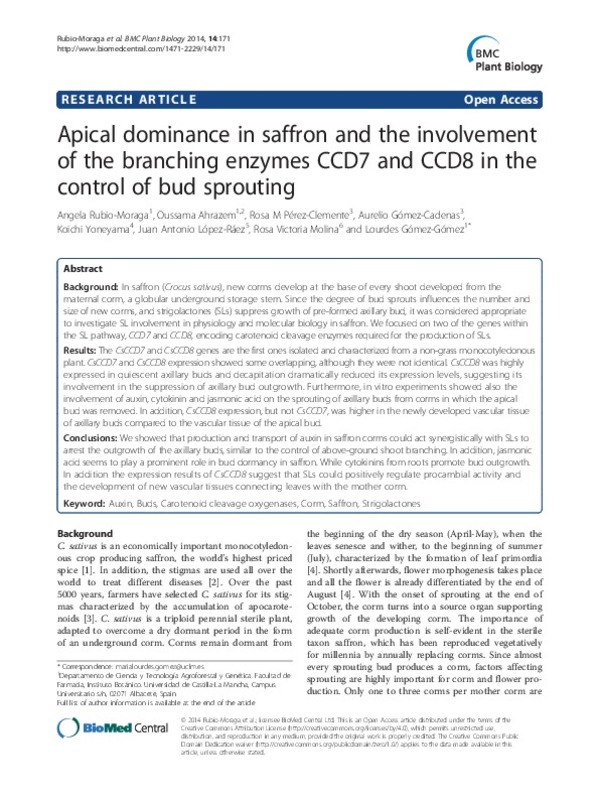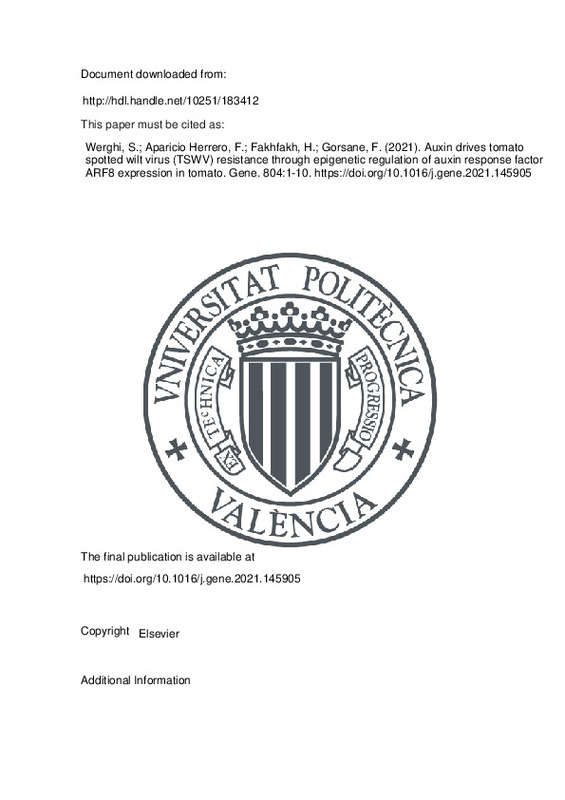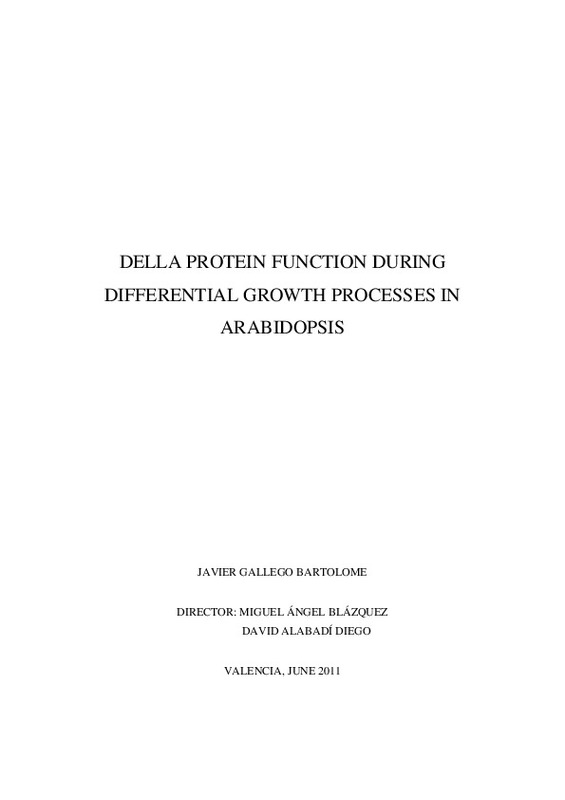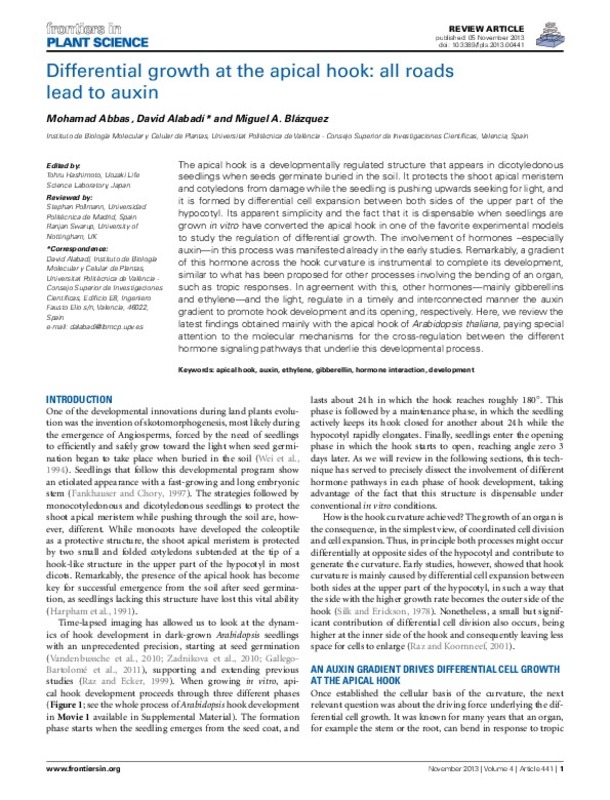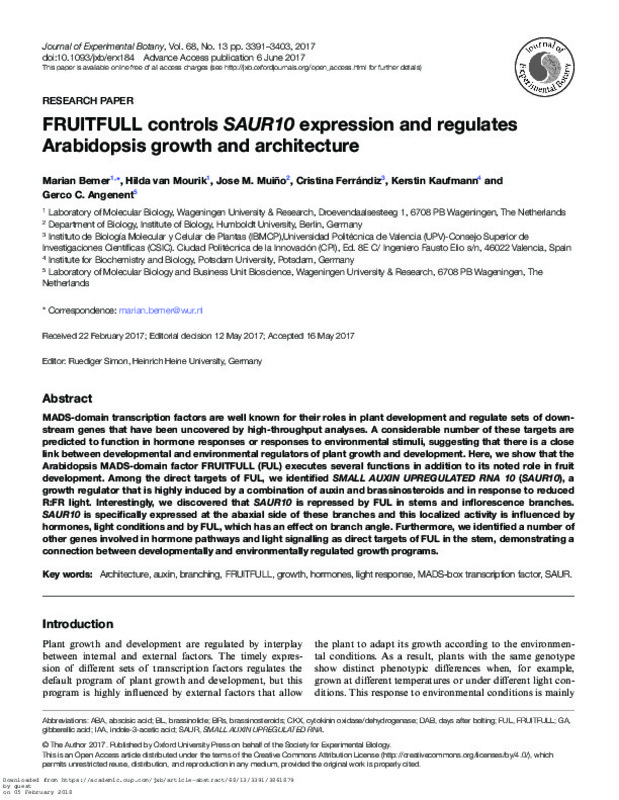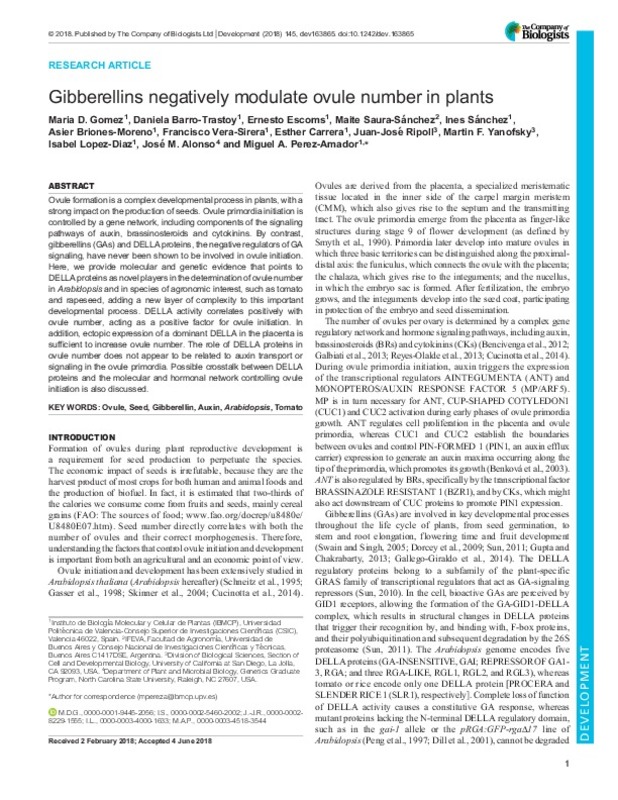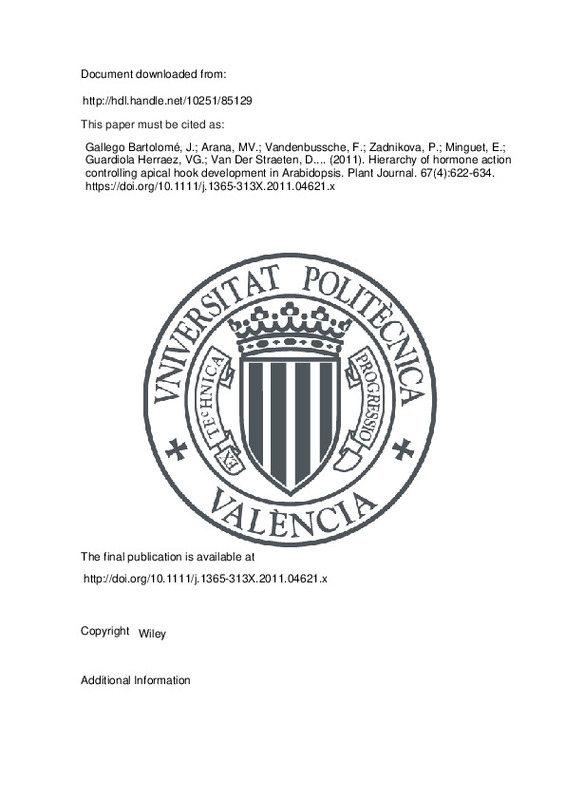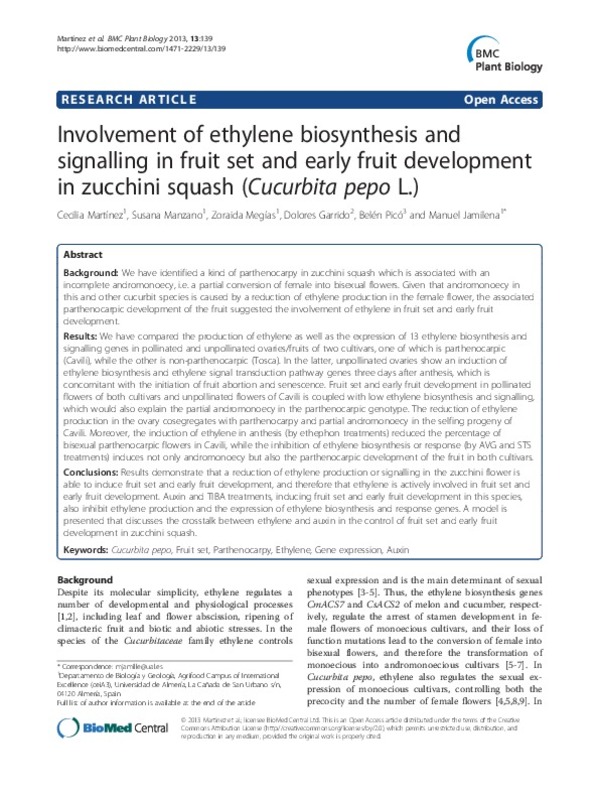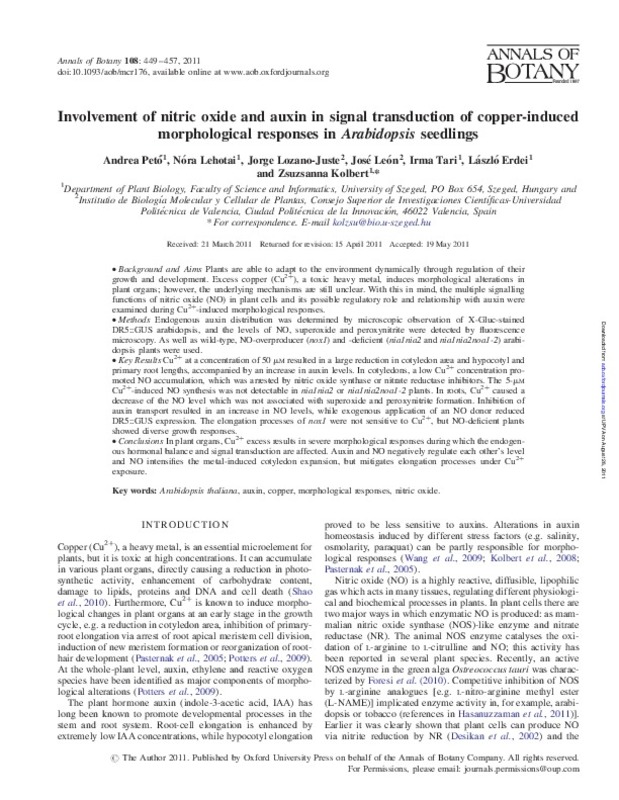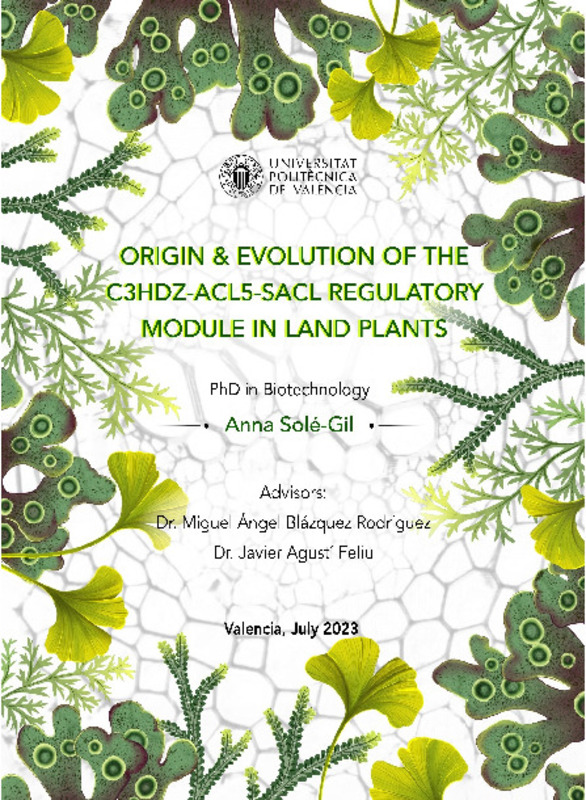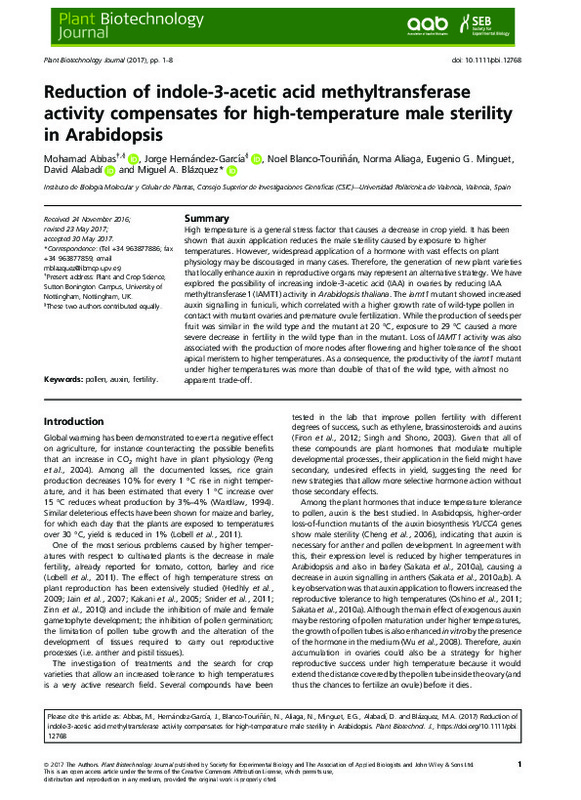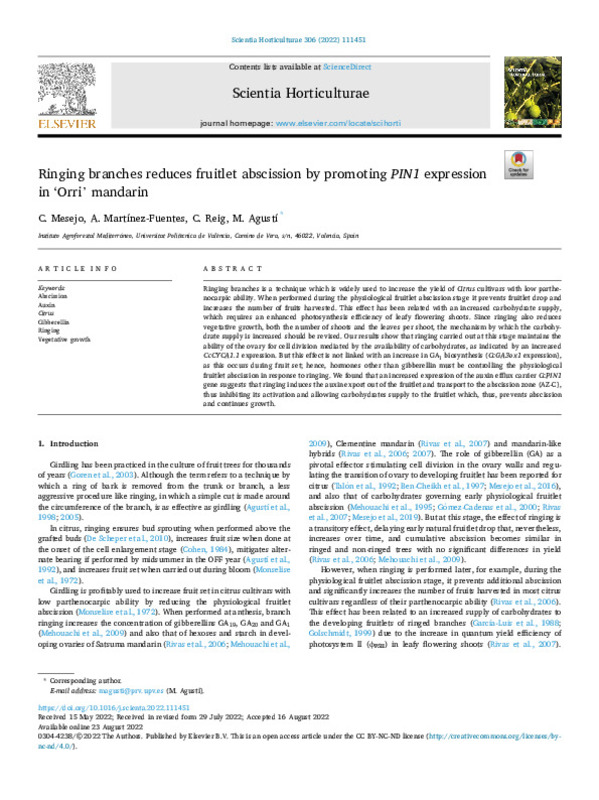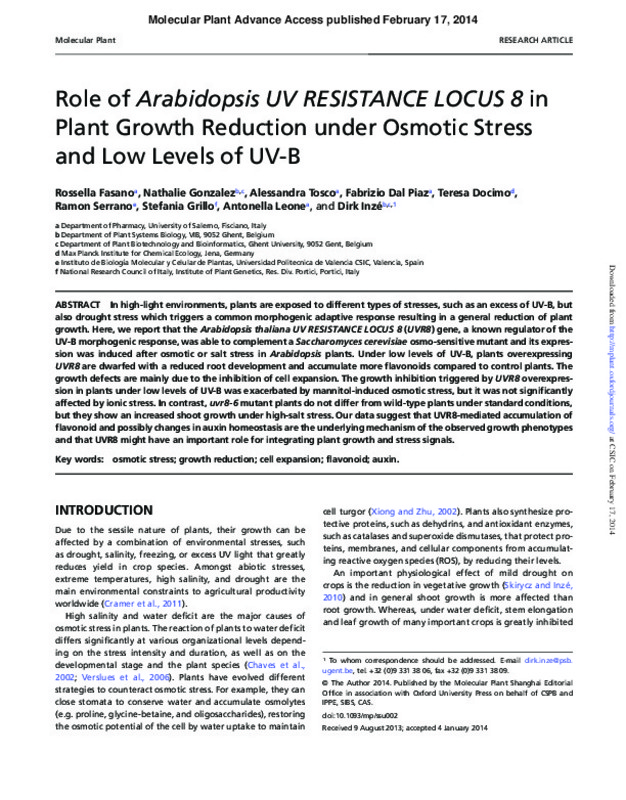

Listar por palabra clave "Auxin"
RiuNet: Repositorio Institucional de la Universidad Politécnica de Valencia
- RiuNet repositorio UPV
- :
- Listar por palabra clave
JavaScript is disabled for your browser. Some features of this site may not work without it.
Buscar en RiuNet
Mi cuenta
Ayuda RiuNet
Admin. UPV
Listar por palabra clave "Auxin"
Mostrando ítems 1-20 de 20
-
Rubio Moraga, Angela; Ahrazem, Oussama; Pérez Clemente, Rosa María; Gomez Cadenas, Aurelio; Yoneyama, Koichi; López Ráez, Juan Antonio; Molina Romero, Rosa Victoria; Gómez Gómez, Lourdes (BioMed Central, 2014-06-19)[EN] Background: In saffron (Crocus sativus), new corms develop at the base of every shoot developed from the maternal corm, a globular underground storage stem. Since the degree of bud sprouts influences the number ...
-
Werghi, Sirine; APARICIO HERRERO, FREDERIC; Fakhfakh, Hatem; Gorsane, Faten (Elsevier, 2021-12-15)[EN] Tomato spotted wilt virus (TSWV) causes severe losses of tomato crops worldwide. To cope dynamically with such a threat, plants deploy strategies acting at the molecular and the epigenetic levels. We found that tomato ...
-
Gudiño, M.; Blanco-Touriñán, Noel; Arbona, V.; Gómez-Cadenas, Aurelio; Blazquez Rodriguez, Miguel Angel; Navarro-García, F. (Oxford University Press, 2018-10)[EN] The presence of antibiotics in soils could be due to natural production by soil microorganisms or to the effect of anthropogenic activities. However, the impact of these compounds on plant physiology has not been ...
-
Fresquet Corrales, Sandra (Universitat Politècnica de València, 2011-09-06)En trabajos previos en levadura se ha demostrado que la sobreexpresión de FPR1, una inmunofilina de tipo FKBP (FK506 binding proteins), confiere tolerancia a los ácidos orgánicos débiles, como el ácido acético y el sórbico. ...
-
Gallego Bartolomé, Javier (Universitat Politècnica de València, 2011-08-01)The plant hormones gibberellins (GAs) regulate multiple processes of plant development. Most of this regulation occurs at the transcriptional level, through the activity of the DELLAs, which are nuclear-localized proteins ...
-
Abbas, Mohamad; Alabadí Diego, David; Blazquez Rodriguez, Miguel Angel (Frontiers Media, 2013-11-05)[EN] The apical hook is a developmentally regulated structure that appears in dicotyledonous seedlings when seeds germinate buried in the soil. It protects the shoot apical meristem and cotyledons from damage while the ...
-
Villanueva Párraga, Gloria (Universitat Politècnica de València, 2016-09-05)[ES] En nuestro laboratorio hemos iniciado el estudio del papel de la hormona giberelina (GA) en la formación de los óvulos de tomate. Mediante el análisis de mutantes, con alteraciones en los niveles hormonales o en su ...
-
Bemer, M.; van Mourik, H.; Muiño, Jose M.; Ferrandiz Maestre, Cristina; Kaufmann, K.; Angenent, G.C. (Oxford University Press, 2017)[EN] MADS-domain transcription factors are well known for their roles in plant development and regulate sets of downstream genes that have been uncovered by high-throughput analyses. A considerable number of these targets ...
-
Gómez Jiménez, Maria Dolores; Barro-Trastoy, Daniela; Escoms, E.; Saura-Sanchez, M.; Sanchez, I.; Briones-Moreno, Asier; Vera Sirera, Francisco José; Carrera Bergua, Esther; Ripoll, J.J.; Yanofsky, Martin; Lopez Diaz, Isabel; Alonso, J.M.; Perez Amador, Miguel Angel (The Company of Biologists, 2018-07)[EN] Ovule formation is a complex developmental process in plants, with a strong impact on the production of seeds. Ovule primordia initiation is controlled by a gene network, including components of the signaling pathways ...
-
Gallego Bartolomé, Javier; Arana, María Verónica; Vandenbussche, Filip; Zadnikova, P.; Minguet, E.G.; Guardiola Herraez, Vicente Gerardo; Van der Straeten, Dominique; Benková, Eva; Alabadí Diego, David; Blazquez Rodriguez, Miguel Angel (Wiley, 2011-08)[EN] The apical hook develops in the upper part of the hypocotyl when seeds buried in the soil germinate, and serves to protect cotyledons and the shoot apical meristem from possible damage caused by pushing through the ...
-
D'Asaro, Antonio; Reig Valor, Carmina; Martinez Fuentes, Amparo; Mesejo Conejos, Carlos; Farina, Vittorio; Agustí Fonfría, Manuel (Elsevier, 2021-05-10)[EN] The avocado tree (Persea americana Mill.) has two types of shoots, indeterminate, which maintain vegetative development from an apical bud, and determinate, which do not have vegetative growth. Indeterminate shoots ...
-
Reig Valor, Carmina; Martinez Fuentes, Amparo; Mesejo Conejos, Carlos; Agustí Fonfría, Manuel (Springer-Verlag, 2018)[EN] In persimmon (Diospyros kaki Thunb.), one to three waves of fruit abscission can occur. The parthenocarpic cv. Rojo Brillante may abscise close to 50% of flowers, which implies a major economic losses. In order to ...
-
Barro-Trastoy, Daniela; Gomez, Maria Dolores; Tornero Feliciano, Pablo; PEREZ AMADOR, MIGUEL ANGEL (Springer-Verlag, 2024-01-28)[EN] As seed precursors, ovules are fundamental organs during the plant life cycle. Decades of morphological and molecular study have allowed for the elucidation of the complex and intricate genetic network regulating ovule ...
-
Martinez, C.; Manzano, S.; Megias, Z.; Garrido, D.; Picó Sirvent, María Belén; Jamilena, M. (BioMed Central, 2013-09-22)Background: We have identified a kind of parthenocarpy in zucchini squash which is associated with an incomplete andromonoecy, i.e. a partial conversion of female into bisexual flowers. Given that andromonoecy in this and ...
-
Petó, Andrea; Lehotai, Nóra; Lozano Juste, Jorge; Leon Ramos, Jose; Tari, Irma; Erdei, László; Kolbert, Zsuzsanna (Oxford University Press (OUP): Policy B - Oxford Open Option A, 2011-05-19)Background and Aims Plants are able to adapt to the environment dynamically through regulation of their growth and development. Excess copper (Cu2+ ), a toxic heavy metal, induces morphological alterations in plant ...
-
Solé Gil, Anna (Universitat Politècnica de València, 2023-09-07)[ES] El correcto desarrollo de tejidos vasculares depende del ajuste preciso entre la proliferación de células vasculares y la diferenciación celular. En Arabidopsis thaliana, la proliferación de células vasculares en el ...
-
Abbas, Mohamad; Hernández-García, Jorge; Blanco-Touriñán, Noel; Aliaga, Norma; Minguet, E.G.; ALABADÍ DIEGO, DAVID; BLAZQUEZ RODRIGUEZ, MIGUEL ANGEL (Blackwell Publishing, 2018-01)
-
Mesejo Conejos, Carlos; Martinez Fuentes, Amparo; Reig Valor, Carmina; Agustí Fonfría, Manuel (Elsevier, 2022-12-15)[EN] Ringing branches is a technique which is widely used to increase the yield of Citrus cultivars with low parthenocarpic ability. When performed during the physiological fruitlet abscission stage it prevents fruitlet ...
-
Fasano, Rosella; Gonzalez, Nathalie; Tosco, Alessandra; Dal Piaz, Fabrizio; Docimo, Teresa; Serrano Salom, Ramón; Grillo, Stefania; Leone, Antonella; Inze, Dirk (Oxford University Press (OUP), 2014-05)In high-light environments, plants are exposed to different types of stresses, such as an excess of UV-B, but also drought stress which triggers a common morphogenic adaptive response resulting in a general reduction of ...
-
Marzal Blay, Andrés (Universitat Politècnica de València, 2025-02-22)[ES] En los cítricos, la baja temperatura promueve la inducción floral en otoño-invierno aumentando la expresión del gen promotor CiFT3 (homólogo en los cítricos del gen FLOWERING LOCUS T). La presencia de un gran número ...
Mostrando ítems 1-20 de 20

Universitat Politècnica de València. Unidad de Documentación Científica de la Biblioteca (+34) 96 387 70 85 · RiuNet@bib.upv.es


